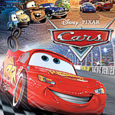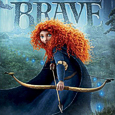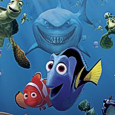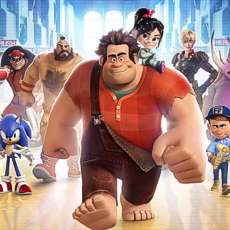Pixar Animation Studios/Walt Disney Pictures (June 9 2006), Walt Disney Studios Home Entertainment (November 10 2009), 2 disc gift set, 116 mins plus supplements, 1080p high-definition 2.39:1 widescreen, Dolby Digital 5.1, Rated G, Retail: $49.99
Storyboard:
Cars is back on disc for a triple-dip, loading the chassis with both Blu-ray and DVD editions, plus two die-cast Cars cars.
The Sweatbox Review:
There are some movies that one just can’t find a connection with. Sure, the motor hums along fine and it’s a nice enough ride, but you just don’t click. Very often, this is the result of too much hype or high expectations on the viewer’s part, leading to disappointment. Other times, the movie can just not be very good. For me, at least, Cars is the film from Pixar’s first decade that just doesn’t do it for me. It could legitimately be argued that, after the enormous success of Toy Story, this is director John Lasseter’s “difficult second movie”. Yes, he also helmed the Studio’s second and third features A Bug’s Life and Toy Story 2, but he had co-directors helping steer their directions.

A pitfall often fallen into by successful first-time directors is a tendency to over indulge themselves on their follow-ups, especially when phenomenal critical and commercial success has awarded them the final say over whatever the producing Studio’s suggestions. Such, I believe, is the case with Cars, which is only Lasseter’s second solo outing and one that seems to have “more” of everything in it. It’s certainly the most commercial and pop-culture heavy of the Pixar releases, and though I wouldn’t offend it by saying it resembles DreamWorks’ Shark Tale, it often comes off not being too far apart from that film in the event. Far from the “what if” fantasies of toys that come to life or monsters hiding in the closet – which we all know are real anyway – we’re asked to believe in a world that has totally be built and exists just for the likes of the Cars characters to drive around in.
If I’m being honest, it’s this central concept that had me struggling to buy into the film from the outset. As with a lot of people, the previews didn’t win me over and when the movie eventually came out, even with Pixar’s impressive track record behind it, I still wasn’t that excited to sit down and concentrate on a movie whose “great idea” is that cars can live, think and drive for themselves. On DVD, as happens so often after seeing a film and being disappointed with it, I warmed to it much more, but returning to it again now, in a new Blu-ray “Ultimate” set that bundles in the previously released BD and DVD editions, it just has to be said that Cars is too long, at almost two hours, to sustain its very slight story. It may well be that the merchandise is among Pixar’s biggest sellers, and capturing that market again here is all too shamelessly clear given the two car models bundled into the box, but in terms of filmmaking, Pixar did, at some point, have to take a dent in their previously meticulous fender, and Cars is it.

It does have to be said that the opening frames of the movie, when we glimpse Lightning McQueen pulling out from the shadows, do set things up for a fun ride. These scenes also perfectly capture the frenetic camerawork of TV sports coverage while blending it in seamlessly with the epic look that Lasseter’s choice of widescreen framing provides, and shoves the film into an instant high gear. Owen Wilson puts in some very good voice performance work here, but it didn’t quite break away from the “Frat Pack” nickname that Wilson’s particular ensemble of movie-star friends have been coined; the rivalry between his McQueen character and the Michael Keaton-voiced Chick Hicks reminded, intrusively, of the same shtick in Anchorman and the like. But Keaton (who obviously has a thing for Disney automobiles after appearing with Herbie the year before) is also great vocal value, voicing his character with a new exuberant lack of restraint unlike anything we’ve ever heard him do before!
However, for all the top-of-the-line sights and sounds, the movie stalls more than the Lamp’s customary high quality mark, and most of this can be attributed to the weaker than usual storyline, a surprise coming from a company who place such emphasis on such things. What’s most interesting is that Lightning is essentially the villain of the piece and the film charts his character’s arc to “good guy” rather than painting him as such from the outset and having him come up against someone meaner. Pixar “doesn’t do villains”, but McQueen certainly comes off as more than just an arrogant fool in the early scenes even if he doesn’t actually cheat to win.
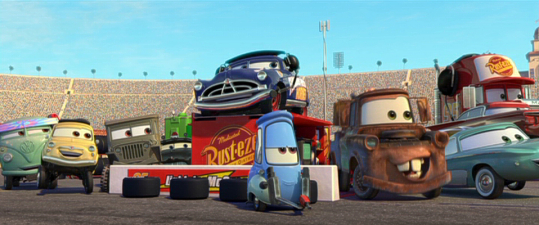
There are also several unavoidable contradictions in the film that one can’t get over even if we want to believe that the whole thing is taking place within an alternate automobile world. Without starting to ask the “big questions” (like where they came from, who built them and what do they have in their insides if they don’t need seats for us humans to sit in?), Cars doesn’t help itself by packing in some truly howling slip-ups that beg the questioning behind their choices. Why the small buttons on phones – how do the cars operate them? Who builds the buildings with those thousands of intricately rendered bricks? Why do they need them? Who finds the gas to fill the pumps? Who built the roads in the first place and what is the point of these entities if they were not designed with human transport in mind?
Even while trying to shift this out of mind, we are presented with the real corker: a line of dialogue, in fact, that screams out the main problem with the overall idea. “Respect the classics, man,” one motor shouts out, “It’s Hendrix”. What, to the cars of “Car World”, is a “man”, and who is Hendrix, and how does he play that guitar if he’s also a car?
An early decision to have the cars’ eyes appear in the windows as opposed to the perhaps more traditional headlight placing was actually never a problem for me, though the fact that all of the cars’ pupils are interchangeable and do not sport any personal characteristics is perhaps one of the drawbacks of computer animation. But the history of cartooning is steeped with such an approach in a number of classic era films, from Pedro the mailplane in Saludos Amigos, the tugboat family of Little Toot, Tex Avery’s spoofs One Cab’s Family and Little Johnny Jet and, of course, Susie The Little Blue Coupe, which has been cited as one of director Lasseter’s favorite shorts and a direct influence on Cars.
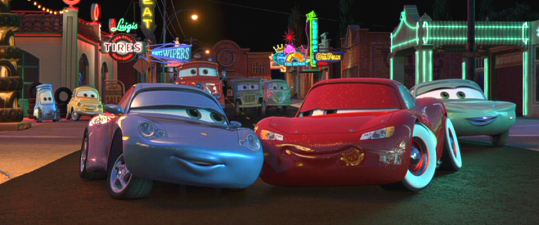
But what made those, especially Susie, really work was that they were set in our real world, where it oddly seems much more believable for a car to exhibit human characteristics than it does for the audience to suspend disbelief and ask them to join you in a strange other-world that doesn’t set itself up strongly enough to abide by its own rules. It’s the same problem that Chris Wedge’s Robots had to some degree, though that film never placed a time frame or human-world reference on its location and could have been, for all we know, set thousands of years in the future when such a reality may come to pass. Cars also shares Robots’ hyperactive approach, which can become weary, and while the jokey ESPN-styled interstitial spoofs are fun, there’s probably a couple too many and they often felt thrown in just to jump-start the flagging storyline.
And Cars does flag, most noticeably around the 50 minute mark, where the film becomes overly talky, the laughs dry up, and Lasseter, for a while, seems to run out of gas. Overall, the movie is easily 15 minutes too long, and the middle of the film doesn’t help matters by becoming overly cutesy, with Lighting and Mater’s bonding sequence certainly something that felt like it would have made a much more enjoyable deleted scene. I’m previously unaware of Larry The Cable Guy’s act, but his Mater was fun, and I’m guessing that he’s a very toned down version of Larry’s standard routine, judging by the one near the mark comment: “He did what in his cup?” But by far the funniest characters, and they know it, are the Italian, Ferrari-loving tyre specialists, stealing every scene that they’re in, though going on the many other types of transportation on show, maybe the movie should have been called “Vehicles”!?
Lighting and Mater’s bonding, at that moment, serves no purpose other than to provide some mid-movie action – albeit brief – and again perhaps would have been better off presented as part of the Mater And The Ghostlight short to be found amongst the discs’ bonuses. Efforts to pull at the emotion strings ring a little hollow and even Lightning’s eventual “respect” for Doc Hudson seems to be motivated by the Doc’s past as the racing Hudson Hornet and for what Lightning can gain from this relationship. The Our Town sequence seemed, to me, to be a sudden change of track, but didn’t work…until this point Radiator Springs had been full of crazy and lovable buckets of bolts, and all of a sudden we’re supposed to care for their surroundings? It was a moment that felt shoehorned in, came from nowhere, and was not as intricately threaded into the story as it might or should have been, or as well as the Doc’s subplot, which turns out to be the real little turnaround story going on in this movie, and Paul Newman’s performance, all warm tones and expressive, layered acting, is the true highlight.

Things get back on the road as Lightning and Sally finally take their inevitable spin together – it’s here we actually feel we could eventually warm to McQueen and that his experiences in the town are starting to touch him. But why didn’t the population of the town pick themselves up before? It turns out nothing was stopping them. Why did it take Lightning McQueen to coming barging in to get them to light up the neon? And again, why does all this happen off camera when a montage might have really shown the turning point in McQueen’s thinking? Even though it’s never anywhere near being a crashing wreck, it’s choices like these that has Cars almost firing on all cylinders in spite of making too many wrong turns along the way.
And then, by the final race, in which McQueen participates of course, and for all he has learned (and benefited from a shiny new paint job and flashy tyres), Lightning seems more than happy to jack this all in as quick as possible and swap it all back for his old stickers and Lightyears. Here, Lasseter’s ace direction comes to the fore once again – something that otherwise didn’t feel as strong as usual throughout the rest of the picture (which is co-credited and dedicated to the late Joe Ranft, though this is the first time I’ve ever seen an entire orchestra also noted in the end credits!). Ultimately, and whether Lightning would have really finished the race the way he does is open to debate – and has been – but the end result is essentially the same and his final stretch of the circuit isn’t played for all the suspense it could have been – mainly because, at the end of the road, Cars is really a relationship movie masquerading as a family cartoon about automobiles.
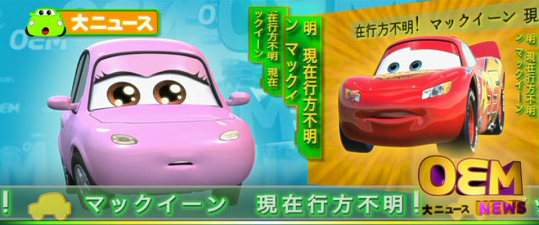
That’s not to say Cars doesn’t work as a whole: it’s without doubt another finely tuned family seater from the Pixar plant. However, by the film’s end I personally got a sense that I had been well and truly entertained but hadn’t been touched by the experience, the preachy central section still feeling out of place and not integrated well enough. The closing credits liven things up no end: instead of Lasseter’s famed outtakes we get a few more character sketches that amount to a little more story, and a Pixar homage which, while enormously engaging, is a little in danger of becoming too self-congratulatory until the final joke is paid off by regular voice and lucky charm John Ratzenberger – a classic cap off.
If I have been dwelling on the negative aspects, forgive me, but that’s what stuck in my mind the most after seeing Cars. The rest, funnily enough, was all surface gloss and sheen, not unlike Lightning McQueen’s character or a gleaming wax job coating on an old banger made up to look shiny as a new roadster. There are some good and fine points about the movie, and indeed a great many of them too (the gentle digs at the nature of how humans deck out their own cars are hilariously amusing, the spoof on how the Japanese completely fill their TV frames block-solid is laugh-out-loud funny, and the pop tunes work surprisingly well alongside Randy Newman’s otherwise very Randy Newman-esque score). Though it sometimes strays from the beaten track, which it otherwise sticks to predictably in terms of characters and story elements, Cars is a fun enough ride, though not everyone may find they enjoy the journey.
Is This Thing Loaded?
When Cars came to DVD in 2006, we told you to get ready to “do the double dip”, and here it is! The original DVD was as close to bare bones as one could get without using that term, lightly packed without Pixar’s usual features: there was no commentary with director Lasseter for one thing, despite the fact the film is apparently “close to his heart”, a sure pointer that a better disc was already in the offing. That most certainly was, as we found out a year later with the release of Cars on the hi-def Blu-ray format, now featuring just such a commentary and a host of other extras, all of which are included in this new re-packaging, because this new re-packaging, in terms of the disc content, is exactly that: both the original 2006 DVD and the 2007 Blu-ray, nothing more, nothing less.
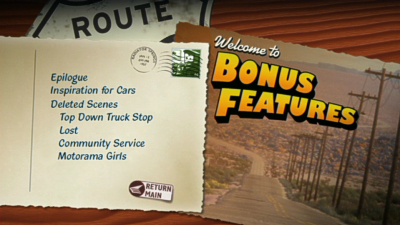
Which means that, on the DVD, we are presented with a grouping of now dated Disney titles “coming” to theaters or home video. Some play by default, but all are available on the disc’s very funny, Pixar skewered Sneak Peeks menu, including the teaser for Pixar’s Brad Bird-directed Ratatouille and, all in anamorphic widescreen, previews for Disney’s Meet The Robinsons, the Peter Pan Platinum Edition, Disney’s Blu-Ray, a short Cars-themed NASCAR advertisement for Disney’s ESPN channel and the movie’s video game. Ahh, that company synergy smell!

On to Cars’ DVD extras proper, and first up, though nowhere as promoted as another short on the disc, is the animated film that played with Cars in theaters, One Man Band, presented correctly in 2.39:1 anamorphic widescreen. As per normal, it’s the simple set up that pays off in a Pixar short, and One Man Band is no exception, its short four-and-a-half minute length proving that less is indeed more. Those who love the film would do well to seek out The Pixar Short Films Collection, where it comes with commentary from writer-directors Andrew Jimenez and Mark Andrews.

The “big extra” on the DVD is the specially produced Mater And The Ghostlight animated short, here shown in its direct-to-DVD screen dimensions of 1.78:1 anamorphic widescreen and lasting a generous seven minutes. Depending on how much you liked the Mater character will impress how much you go for the short, but as noted above, I felt that the bonding sequence in the main feature might have played much better as a set-up for this film, which essentially expands upon an idea from that moment anyway. It’s fun and breezy, with a killer post-credit end gag, but feels more like the bonus promotional item that it really is, not being clear if its supposed to be set during, or after, the main feature.
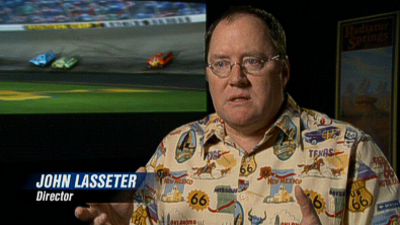
Inspiration For Cars is our token look behind the scenes that mostly has John Lasseter, and most touchingly co-director Joe Ranft, talking up the film for 16 minutes. We get a glimpse at the many hours footage the crew shot in 2001 on the real Route 66, highlights and nice touches including finding out that Lasseter’s own Dad was in car sales, and that Route 66 historian and the directors’ guide along their road trip, Michael Wallis, was asked to provide the voice of Radiator Springs’ Sheriff as a thank-you. Wallis gets a lot of screen time in the road footage, we also hear from John’s Dad Paul, who talks about the family’s car vacation trips, and take a peek at John’s own family home movies. It gets a little close to repeating Lasseter’s paean to small town America, but it’s interesting to see the real life racers and personalities who inspired characters in the film (it started life as the story of an electric car in a gas-guzzling world), though Lasseter perhaps comes off as “trying too hard” to make everyone else see what he’s seeing, and it’s a surprisingly adult and dry production featurette for what is ostensibly a light-hearted kids disc.
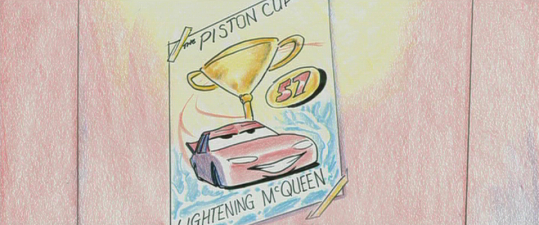
Lastly on the DVD, we come to a selection of Deleted Scenes, that run well over 10 minutes using the handy Play All option. Introduced briefly in voice over by director Lasseter, four animated storyboard sequences play out in all, with the best of the bunch being an alternative – and more “plausible” – explanation for McQueen’s drop off from his truck (look out for Lightning’s original sticker number 57, marking Lasseter’s birth year before it was changed to 95 in respect of Toy Story’s groundbreaking debut), and a “bodywork swap” scene that’s all too clear as to why it ended up being junked. Though there’s a lack of the really meaty features usually associated with Pixar’s DVDs, the “More!” of the back packaging refers to the End Credit “Epilogue” Sequence, playable without the distraction of those bothersome crew member names and blown up to fill the widescreen frame.
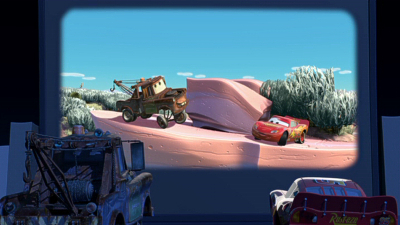
Actually, it’s a nice touch to be able to see the detail close up, and keep your eye out for an Easter Egg on the main menu (if you let it run through long enough – hint: “Dinoco”). This plays an extended deleted clip from the Epilogue: a short section of a Cars take on Boundin’ (would it have been called “Drivin’”?) in which the similarities between the Jackalope from Bud Luckey’s delightful short and Mater (which I found hysterical after I’d made the point during the main feature) are made all too obvious!
On the Blu-ray Disc, all of the above supplements are available, with the bonus shorts presented in HD and the Sneak Peeks replaced with trails (in HD) for Enchanted, WALL-E, Meet The Robinsons and Ratatouille. Cars was serviced much more appropriately second time around the track, with features feeling a little more substantial in comparison to those we are offered on new discs. The disc is split into two main sections: Radiator Springs takes us to the drive-in for the movie and more light-hearted extras, from the Car Finder game, in which one must keep track of all the vehicles through the movie, a neat idea but one that gets old quick, to the bonus shorts.
Heading back down Route 66, the other option is to Tour Pixar Animation Studios, where the behind the scenes material is stored. Disney’s much-hyped Cine-Explore feature kicked into high gear with this release, providing not one but two unique – and much needed – Audio Commentaries, with director Lasseter and the production team respectively. As Lasseter describes in a one minute intro, these tracks can be accompanied by additional on-screen images, clips, concept art, and other interesting production artefacts, such as the added material also optional elsewhere. We can thank the magic of Blu-ray for these additions, though they stills are only presented as large as the producers of the disc see fit and any further magnification or separate gallery files that would have allowed a closer trawl, is not offered. Nevertheless, this new take on such tracks is certainly an immersive way to find out more, and combines commentary with documentary for a unique peek under the hood.
The seven Documentary Shorts featured in the Cine-Explore commentary are also available as individual selections, covering the production from origination, through character design and animation, and the “geeky details” and graphics featured. Presented in standard definition, these are not really a substitute for a more enveloping documentary, and notable omissions are any of the TV specials or store exclusive material such as the Under The Hood special, but coupled with the Cine-Explore feature switched on, it amounts to a good sampling of footage. There’s no Play All function, but this adds up to almost 35 minutes that wasn’t included on the DVD release.
Finally, in addition to the previous moments cut from the movie, we’re offered one extra Deleted Scene, in which McQueen must attend traffic school in order to be road safe, but apart from the length (at over three minutes), it’s clear why is was dropped early in production. On Blu-ray, Cars features more of what we expect, and the Cine-Explore option makes for a fascinating look at the production even if the fundamental flaw of the central gimmick is never delved into, rather frustratingly. Bundled with the DVD, there’s obviously a lot of overlap, but most notably there are still none of the original theatrical previews (you’d think a disc about cars would have a Trailers section!) and no newly made available footage, such as the Cars Toons or the handful of Mater’s Tall Tales shorts, some of which made their way to theater screens internationally.
Case Study:
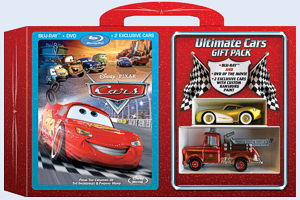 With the discs replicating the exact same content as their 2006 and 2007 original releases, what’s to entice those back to the garage one more time? Offered as an Ultimate Gift Set, this new Cars packs both those original discs into a slightly newly-designed BD case, which simply rearranges the art from the 2007 BD from the then-new and exciting Blu-ray heavy graphics to something more in line with the current Disney BDs.
With the discs replicating the exact same content as their 2006 and 2007 original releases, what’s to entice those back to the garage one more time? Offered as an Ultimate Gift Set, this new Cars packs both those original discs into a slightly newly-designed BD case, which simply rearranges the art from the 2007 BD from the then-new and exciting Blu-ray heavy graphics to something more in line with the current Disney BDs.
It’s the same art, now with a blue-rimmed front cover and a brighter colored reverse sleeve that’s more reflective of the original DVD than the initial Blu-ray covers of the time. Don’t be caught out by the claim that Mater And The Ghostlight is “Now in Hi-Def”…it was always just as so. Although this now looks like a new BD and DVD combo, there just the same discs as before.
What is new is the addition of two Cars cars, which may or may not get your motor running. Although I had a big toy car collection as a kid, I can’t say I’ve bought one in years and, if I did, it would probably be a bit of character merchandise like these. If nothing else, Cars has been a big franchise for Disney in terms of trinkets sold, and is sadly the reasoning behind the upcoming Cars 2.
As such, these kinds of items are highly collectible and doing a little digging around online suggests that these two models – a “Cruisin’ Lightening McQueen” and “Rescue Squad Mater” – have been specially created for this box, with a custom double Ransburg paint job and several alterations from their standalone pack versions (the separate pack-sold Mater has rubber tyres, retractable ladder and removable hose, for instance, not provided here).

The big question though, to a casual fan at least, is why Mater isn’t a rusty brown and McQueen a bright, shining red? Of course, I do understand that marketing and endless toylines produce variations on characters to keep fans buying them over and over, and that’s no doubt the point here, but one might have thought consistency should have been the order of the day here, especially considering that these cars come packed with the original movie, in which McQueen is never gold colored and Mater is never red. All of these items are bundled together in an outer box which could be seen as some kind of mechanic’s tool case, if you squinted hard enough, outlining the two cars’ personalities on the back along with another repeat of the sleeve’s back cover art.
Ink And Paint:
Since these are same discs as before, there’s no reason to think that Cars doesn’t shine, either on the standard def DVD or the super-resolution Blu-ray. Both discs offer an expressive, strongly vibrant and pin-sharp 2.39:1 anamorphic transfer taken directly from Pixar’s digital source, with no sign of the redundant pan-and-scan full-screen edition that was previously sold separately). The Blu-ray is as good as it gets, a beautiful image that copes with the fast paced scenes as well as the more laid back ones, and even the DVD isn’t an old run-around with its THX-certification and optional set-up Optimizer. From the brightest reds to the darkest blacks, Cars looks fantastic and is certainly reference quality demo material. ’Nuff said!
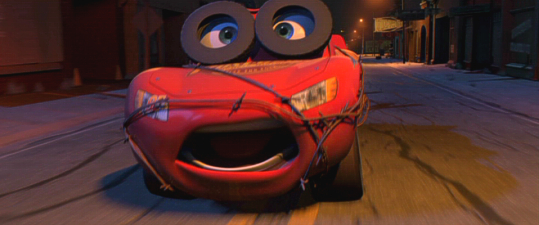
Scratch Tracks:
Early rumors on the specs for this release suggested that Cars’ original uncompressed 5.1 Dolby Digital on its Blu-ray debut might be upgraded to a DTS-HD track, but since they’re the same disc this turns out not to be the case. But it’s still a powerhouse of an animated movie track, really zooming out of the speakers tyres screeching, even in the Dolby Digital EX flavour offered on the DVD. On both editions, I still found that it was perhaps an overly dynamic track, with the loud races coming over like dynamite but with the quieter dialogue scenes reduced to having to crank up the volume – only for the final race to come crashing in louder than expected. It’s a good track, but that’s something to watch out for. English subtitles are provided for the hard of hearing.
Final Cut:
Cars was always about its flashy images, and the original DVD and BD releases both delivered on that front. One gets the feeling that this repackaging is really more of an excuse to sell off a few leftover discs and die-cast models rather than give fans what they really might want. Where is an extra bonus disc of the Cars Toons or Mater shorts that played on Disney Channel, for instance? Do we have to wait for another reissue when Cars 2 is ready to roll off the assembly line? The contents of both discs make up a good selection of expected bonus features, but packing them together doesn’t bring us anything most Cars fans won’t already have. For those coming to the title anew, it’s a good enough package, though expensive, and some might want to wait until the disc comes along for much cheaper without the added cars. In terms of reissues, this feels more like we’re being sold a second-hand truck by a great salesman instead of landing a great deal on a gleaming new sports model.
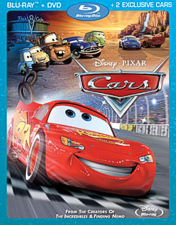 | ||
 |


